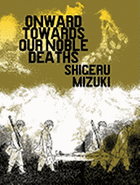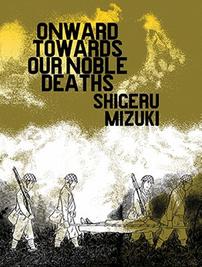
 As Shigeru Mizuki's World War II graphic novel masterpiece approaches 40 years old, Drawn & Quarterly has released the first American translation in a gorgeous production that reads from back to front, from right to left, in true Japanese style and captures a side of the war in the South Pacific you've never seen.
As Shigeru Mizuki's World War II graphic novel masterpiece approaches 40 years old, Drawn & Quarterly has released the first American translation in a gorgeous production that reads from back to front, from right to left, in true Japanese style and captures a side of the war in the South Pacific you've never seen.
Legendary manga artist Mizuki is now nearly 90, currently topping a long, honor-laden career on a daily television show with his wife. Onward Towards Our Noble Deaths, based on his own experiences in the war, which left him one-armed, is one of the greatest antiwar comics ever created.
From his first work, Rocketman, in 1957, Mizuki's unique style has been a combination of highly realistic, painterly backgrounds peopled by cartoony human beings. The juxtaposition of photo-real landscapes (from the breathtaking beauty of the Pacific islands to accurately drawn bomber planes) with simply drawn comic-book soldiers is somehow harrowing--charming, slightly goofy characters losing their limbs and lives in cartoon explosions.
With hundreds of vignettes, Mizuki captures the brutal lives of enlisted men serving in the Imperial Army in Papua New Guinea near the end of the war, where soldiers can be ordered to chop off a nearly dead soldier's little finger to prove he died in battle, or to lob back ignited grenades that have been tossed into their trenches. Though there's not enough water, venturing away from the camp to cut a vine stalk to get a few drops of moisture can cost a man his life.
Much of the brutality does not come from the enemy, but from their own commanding officers, who seldom miss a chance to slap down the rookies, subjecting them to repeated beatings and corporal punishments. Due to their rigid military sense of honor, even a sensible tactical retreat is unthinkable. Mizuki presents the reader with the guilt of friendly fire, the waste of good men, the relentless imperative to die rather than be taken prisoner, the shame of surviving.
In a dazzling variety of layouts and frames of all sizes, the reader watches in horror as platoons of endearing characters are ordered to run at the enemy in a banzai charge with no hope of survival. The last few stunning panels have no text. None is needed. Mizuki has made his point, achieving an overwhelming sense of loss. --Nick DiMartino
Shelf Talker: Translated at last, the stunning classic Japanese graphic novel of the Imperial Army in the South Pacific islands at the end of World War II, by Shigeru Mizuki, the 90-year-old father of manga.

